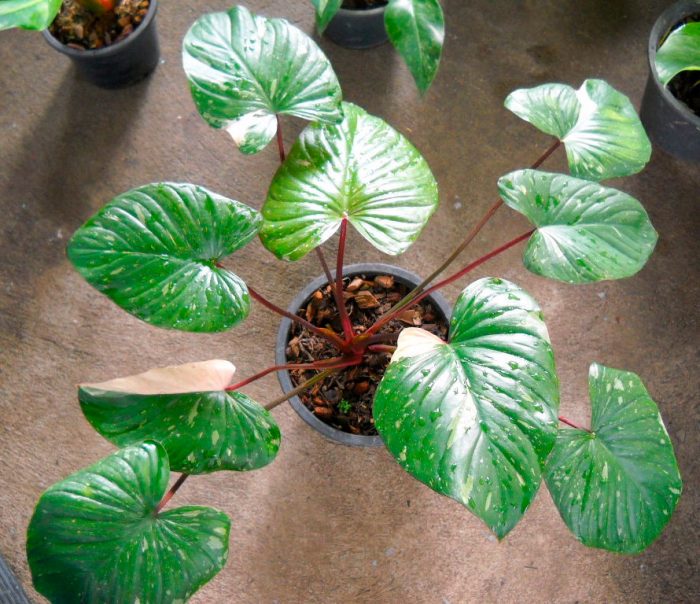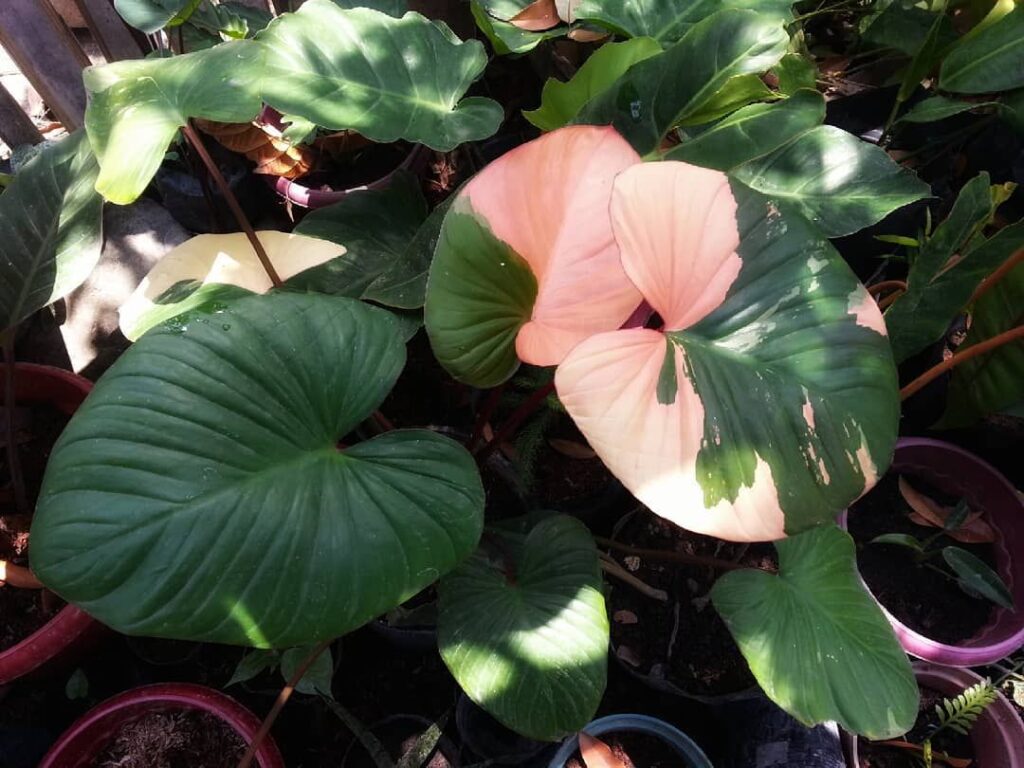The homalomena plant is native to the tropical forest floor in Southern Asia and Southwestern Pacific. But there are few species known to be indigenous to Latin America.
Many homalomena species have a strong anise smell. It is one of the reasons behind their popularity in many homes and offices.
It is always heartbreaking to see your houseplant not growing as expected. Homelomena leaves curling is a common phenomenon when grown at home or in the office.
There is no need to freak out since I got your back. The first thing to consider is to identify the cause and figure out how to save the houseplant.
So, why are my homalomena leaves curling? The possible causes are low humidity and temperature stresses. Other causes are improper watering, over-fertilization, light exposure, diseases, water quality, and pest infestations.
This article provides a detailed insight into the causes of homalomena leaves curling and measures to consider in fixing the issue. Take your time to read through from the start to the end.
You May Also Like: How to Care for Hindu Rope Plant

Causes of Homalomena Leaves Curling (Quick Solutions)
Pest Infestations
Homalomena leaves are vulnerable to spider mites, aphids, mealybugs, and scales. These sap-sucking bugs feed on the plant sap from the leaves, causing them to curl.
The frequent piercing damages the leaf’s vital tissues. The houseplant has to display displeasure by curling its leaves.
These small holes in the leaves create a suitable environment for fungi and bacteria to thrive. You will notice your homalomena plant leaves drooping and developing brown spots.
You can treat insect infestation by use of neem oil spray. It horticulture soap is another ideal alternative for getting rid of spider mites, scales, and mealybugs.
Nutritional Deficiency
Most indoor plants need sunlight, water, and fertilizer to flourish. But homalomena plants can utilize artificial sunlight to undertake their physiological processes.
Nutritional deficiency occurs when the houseplant cannot make use of the nutrients to enhance healthy growth and well-being.
Homalomena leaves will curl and show other symptoms due to a lack of nutrients. The issue can be nerve-wracking regardless of your experience.
The best solution is to consider adding organic fertilizer to improve soil fertility. Keep in mind that the soil pH also affects its fertility. Slightly acidic soil is ideal for homalomena plants.
Temperature Stress
Hot and cold drafts can also make homalomena leaves curl. This houseplant prefers a temperature range of 65-85oF.
Any temperature below or above the optimum requirement will harm the houseplant in many ways. But this indoor plant usually responds by either drooping or curling the leaves.
There is no need to raise concern as the houseplant can bounce back to normal. You only need to provide the optimum temperature requirement.
I recommend keeping your houseplant away from heaters, radiators, and cooling vents. It is the best solution to grow a healthy homalomena plant at home.
Overwatering Issues
Most houseplant enthusiasts tend to worry more about their plants. These doubts force many people to water their indoor plants beyond the required standards.
Too much water causes root rot. The root disease occurs due to a lack of oxygen in the existing potting mix. The condition creates an ideal environment for fungus to grow.
Your homalomena leaves will begin to curl and drop in the long run. If the condition persists for an extended period, the plant will eventually die.
Consider re-potting your houseplant to save it from root rot. Uproot the plant and cut off the affected roots using a sterilized pair of scissors.
Use fresh potting mix in a container with drainage holes at the bottom. These holes will help to get rid of excess water and prevent root rot from occurring.
Too Much Light
Homalomena plants grow under the canopy in their native habitat. It implies that the plant can tolerate low-moderate sunlight.
Direct exposure to direct sunlight for an extended period, the homalomena leaves will get scorched and curl.
The best option is to move the houseplant to a location that receives bright indirect sunlight. But this houseplant can still survive under artificial lighting conditions.
Bright indirect sunlight will not damage the foliage. I recommend keeping the plant in such light condition for about 3-4 hours a day.
Under-Watering
Homalomena leaves will curl and drop when the potting mix gets too dry. Restoring these leaves to their green coloration can be challenging.
But when the leaves are still soft, there is a high chance of recovery. You only need to water the houseplant according to their requirements.
I recommend formulating a watering schedule routine to save your homalomena leaves from curling and drooping.
Always inspect the soil moisture content before watering to avoid overwatering issues. Dealing with an overwatered homalomena plant is a daunting experience.
Lack of Humidity
Homalomena is a tropical plant that thrives in a humid environment. Homalomena leaves will become droopy and curl when placed in an area with a low humidity level.
Other symptoms associated with low humidity are browning, yellowing, and shriveling. Increasing the humidity level will help to salvage your houseplant leaves from curling.
I recommend misting homalomena leaves more often to increase humidity around the plant. You can also install an electric humidifier in the house to resolve the issue.
Water Quality
Unfavorable water quality is the minor cause of homalomena leaves curling. This indoor plant is less sensitive to water purity.
Tap water contains a lot of minerals and chemical compounds. Excessive accumulation of these minerals around the plant will cause leaf curling in the long run.
The use of distilled or filtered water happens to be the best option. It reduces the risk of leaf curling and drooping among houseplants. Rainwater is another excellent option to consider.
Over-Fertilization
Homalomena plants aren’t heavy feeders. These houseplants can still survive without fertilizer. But you need to add adequate organic matter around the plant to improve soil fertility.
Homalomena leaves curling is a problem related to overfeeding. The excessive buildup of salts around the plant damages the roots and inhibits their function.
The houseplant will respond by leaf curling and browning. If the soil condition persists for long, saving the houseplant will be challenging.
The best option is to flush out the soil with distilled water. But recommend re-potting the plant rather than flushing the soil to avoid overwatering issues.
Remember to fertilize the plant twice or thrice during summer and spring. Do not fertilize the plant in winter due to homalomena dormancy.
Plant Diseases
Homalomena leaves are more vulnerable to bacterial or viral infection when grown in a moist environment. Leaf curling, drooping, and yellowing are the most common symptoms.
The rule of thumb is to isolate the affected plant from others. It will help to prevent the spread of disease to other houseplants.
Use fungicides and other commercial treatments to battle plant diseases. Keep your plant leaves drier will help to combat some fungal conditions.
Aging Leaves
Homalomena leaves tend to get old and curl. The mechanism helps the plant to withdraw energy from the aging foliage and redirect to growing parts.
The issue is common to the lower old leaves. There is no need to worry if your older leaves are curling. It is an inevitable situation and cannot be controlled.
Frequently Asked Questions
Why Is My Homalomena Drooping?
Homalomena drooping could be due to under-watering, low humidity, and direct exposure to sunlight. Other causes are temperature stress, pest infestations, and diseases.
Why Are Homalomena Leaves Yellow?
Homalomena leaves turning yellow are due to the aging issue, overwatering, extreme temperatures, low humidity levels, and insect infestations. The rule of thumb is to identify the cause and fix it.
Is Homalomena A Rare Plant?
Homalomena plants are rare. But growing and caring for the homalomena plant is super easy. All the cultivars need plenty of warmth and filtered lighting conditions.
Is Homalomena Rubescens An Indoor Plant?
Absolutely. This tropical plant can tolerate the indoor growing condition without any problem. It requires little maintenance when compared to other houseplants.
Can You Propagate Homalomena?
Yes. Homalomena plants are rhizomatous and can be propagated from the cutting of the rhizomes. The division can only happen when the houseplant is well-established in their pot.

In Conclusion
Homalomena plants have spade-shaped leaves. Leaf curling is a sign of distress and it should be fixed out immediately.
The houseplant enthusiast needs to inspect the plant and identify the reason behind the leaf curling issue. Fixing the homalomena leaves curling problem is super easy.
If you are looking to learn how to grow and care for homalomena plants, consider reading my homalomena plant care guide for a better insight.
More Sources and References
- Peter Boyce. Homalomenae. Researchgate.
- Editor. Homalomena Plant Issues. University of Minnesota.
